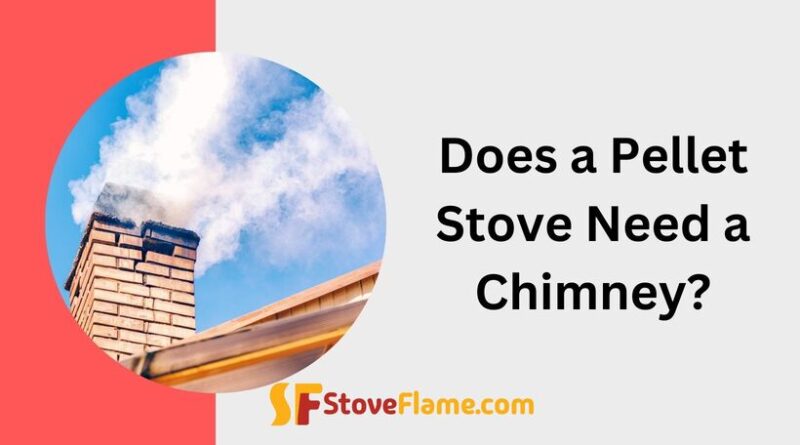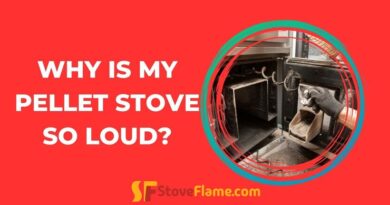Does a Pellet Stove Need a Chimney?
As the demand for alternative heating methods continues to rise, many homeowners are turning to pellet stoves as a cost-effective and environmentally friendly option. However, a common question that arises is whether or not a pellet stove requires a chimney for proper functioning. The answer to this question is not a simple yes or no, as there are multiple factors that come into play.
This article provides an in-depth look into how pellet stoves function and the role of a chimney in their operation. We will explore the different types of chimneys suitable for pellet stoves, as well as the significance of proper installation and maintenance practices. By the end of the article, you will gain a comprehensive understanding of how chimneys contribute to the efficient functioning of pellet stoves.
Whether you currently own a pellet stove or are contemplating getting one, this article aims to offer practical insights to help you make informed decisions about heating your living space.
The Mechanics of a Pellet Stove
In order to understand whether a pellet stove needs a chimney, it’s important to grasp the mechanics of how a pellet stove operates. A pellet stove is a type of wood-burning appliance that utilizes compressed pellets made from wood or biomass materials as its fuel source. These pellets are loaded into a hopper, which then feeds them into a combustion chamber.
Within the combustion chamber, an auger or a screw mechanism delivers the pellets to a burn pot or a combustion area. Here, the pellets are ignited and burn efficiently, producing heat. The combustion process is carefully controlled by a series of sensors and a control panel, ensuring optimal fuel consumption and heat output.
The heat generated by the burning pellets is then distributed throughout the room or house via a fan or a convection system. This efficient and controlled combustion process is what makes pellet stoves an attractive and eco-friendly heating option for many homeowners.
Importance of Proper Ventilation
Proper ventilation is crucial when it comes to operating a pellet stove or any type of wood-burning appliance. Without adequate ventilation, the byproducts of combustion, such as carbon monoxide and other harmful gases, can accumulate indoors and pose a serious health risk.
Additionally, proper ventilation helps to remove excess heat and control the airflow, ensuring the stove operates efficiently and effectively. It’s essential to have a properly installed and functioning chimney or venting system that allows for the safe and efficient release of combustion byproducts outside of the living space. Regular inspections and maintenance of the chimney or venting system are also important to prevent blockages and ensure the proper functioning of the pellet stove. By prioritizing proper ventilation, you can enjoy the warmth and comfort of a pellet stove while keeping your home safe and maintaining air quality.
Types of Ventilation for Pellet Stoves
When it comes to ventilation options for pellet stoves, there are a few different types to consider. One common method is through the use of a direct vent system. This system allows fresh air to be drawn in from outside, while simultaneously expelling combustion byproducts through a separate exhaust vent. Direct venting is a popular choice as it provides a sealed combustion process, minimizing the risk of indoor air pollution.
Another option is a power vent system, which uses a fan to push the exhaust gases out of the stove and through a venting pipe. This type of ventilation is beneficial in situations where a traditional chimney installation is not feasible.
Finally, there are also ventless or vent-free pellet stoves available. These units are designed to operate without a chimney or external venting, instead utilizing a catalytic converter to clean and recirculate the combustion gases back into the room.
It’s important to note that ventless pellet stoves have specific requirements and regulations that must be followed to ensure safe operation. When considering the ventilation for your pellet stove, consult with a professional to determine the best option for your specific needs and to ensure compliance with local building codes and regulations.
Does a Pellet Stove Need a Chimney?
While it is true that pellet stoves offer alternative ventilation options, having a chimney is not always necessary. The availability of direct vent systems and power vent systems allows for efficient and safe operation without the need for a traditional chimney. These options provide a convenient solution for situations where installing a chimney may be challenging or impractical.
Additionally, ventless or vent-free pellet stoves offer a chimney-less option by utilizing a catalytic converter to clean and recirculate combustion gases back into the room. However, it is important to consult local building codes and regulations to ensure compliance and safety when considering a pellet stove without a chimney.
Factors to Consider When Choosing Pellet Stove Venting
When choosing pellet stove venting, there are several factors to consider to ensure proper installation and optimal performance. First, it is important to determine whether a horizontal or vertical venting system is suitable for your space. Horizontal venting works well for homes with accessible exterior walls, while vertical venting is necessary for multi-story buildings or if the stove is located away from exterior walls.
Additionally, you should consider the clearance requirements for vent pipes, as they need to be properly spaced from combustible materials to avoid any safety hazards. It is also crucial to choose the correct vent pipe size for your pellet stove, as using an undersized or oversized pipe can lead to inefficient operation and potential damage.
By considering these factors, you can select the appropriate pellet stove venting system for your specific needs and enjoy the benefits of a well-ventilated and efficient heating solution.
Benefits of Having A Chimney
Having a chimney for your pellet stove offers numerous benefits that enhance the overall functionality and enjoyment of your heating system. One of the main advantages is improved ventilation. A chimney efficiently removes the combustion byproducts, such as smoke, fumes, and excess heat, from your home, creating a cleaner and healthier indoor environment.
Additionally, a chimney helps to direct the stove’s exhaust gases safely outside, minimizing the risk of carbon monoxide buildup and potential health hazards. Furthermore, a chimney provides a natural draft, which aids in the efficient burning of pellets, ensuring maximum heat output and fuel efficiency. It also allows for better control of the stove’s temperature and airflow, providing a more comfortable and consistent heating experience.
Lastly, a chimney adds an aesthetic appeal to your home, creating a cozy and rustic ambiance that many homeowners appreciate.
Disadvantages of Having a Chimney
While having a chimney for your pellet stove offers various advantages, it’s important to consider the potential disadvantages as well. One of the main drawbacks is the maintenance and upkeep required. Chimneys need regular cleaning to remove soot, creosote, and other debris that can accumulate over time, which can be a time-consuming and dirty task.
Additionally, chimneys can be prone to damage from weather conditions such as heavy rains, snow, or strong winds, which may require repairs or even replacement.
Another disadvantage is the potential for heat loss. Chimneys can act as a conduit for heat to escape from your home, especially if they are not properly insulated or sealed. This can result in reduced energy efficiency and increased heating costs.
Furthermore, chimneys may require periodic inspections to ensure they are in good condition and meet safety standards. It’s important to keep these factors in mind when considering whether or not to have a chimney for your pellet stove.
Differences between a Traditional Chimney and Venting Tubes
When comparing a traditional chimney to venting tubes for a pellet stove, there are several key differences to consider. Firstly, a traditional chimney requires the construction and installation of a physical structure, which can be costly and time-consuming. Venting tubes, on the other hand, are flexible and can be easily routed through walls, ceilings, or floors, providing more flexibility in terms of placement within your home.
Additionally, traditional chimneys require regular maintenance and cleaning to remove buildup and ensure proper airflow, while venting tubes generally require less maintenance.
Another notable difference is the insulation factor. Chimneys can lose heat, as they are exposed to the external environment, whereas venting tubes are often insulated, preventing heat loss and potentially improving energy efficiency.
Lastly, venting tubes can be more easily adjusted or relocated if needed, offering greater versatility. Overall, when deciding between a traditional chimney and venting tubes for your pellet stove, it’s important to consider factors such as installation, maintenance, insulation, and flexibility to determine which option best suits your needs.
Types of Pellet Stoves That Do Not Require a Chimney
When it comes to pellet stoves, there are also options available that do not require a chimney. One such type is the vented pellet stove, which utilizes a direct venting system. These stoves are designed to draw in fresh air from the outside and expel combustion gases through a small pipe, eliminating the need for a traditional chimney. They can be installed in any room with proper ventilation, providing a convenient and efficient heating solution.
Another option is the vent-free pellet stove, which operates without the need for any external venting. These stoves are designed to burn the pellets cleanly, ensuring that all combustion byproducts are safely filtered and released into the room. They are ideal for spaces where installing a chimney or venting system may not be feasible. It’s important to consult with a professional to determine the best type of pellet stove for your specific needs and to ensure proper installation and safety measures are followed.
Final Thoughts
If you are considering purchasing a pellet stove but are unsure if you need a chimney, I hope this blog post has provided you with helpful information. While some pellet stoves do require a chimney for proper ventilation, there are also options available that do not. It is important to research and consult with a professional before making a decision. Whether you choose a chimney-less option or not, a pellet stove can be a great addition to your home and provide warmth and cost savings.
I'm Daniel Miller, the proud owner of StoveFlame. With over five years of experience in this dynamic field, I've honed my skills and passion for delivering top-notch quality and accuracy in everything I do.





